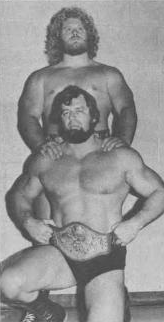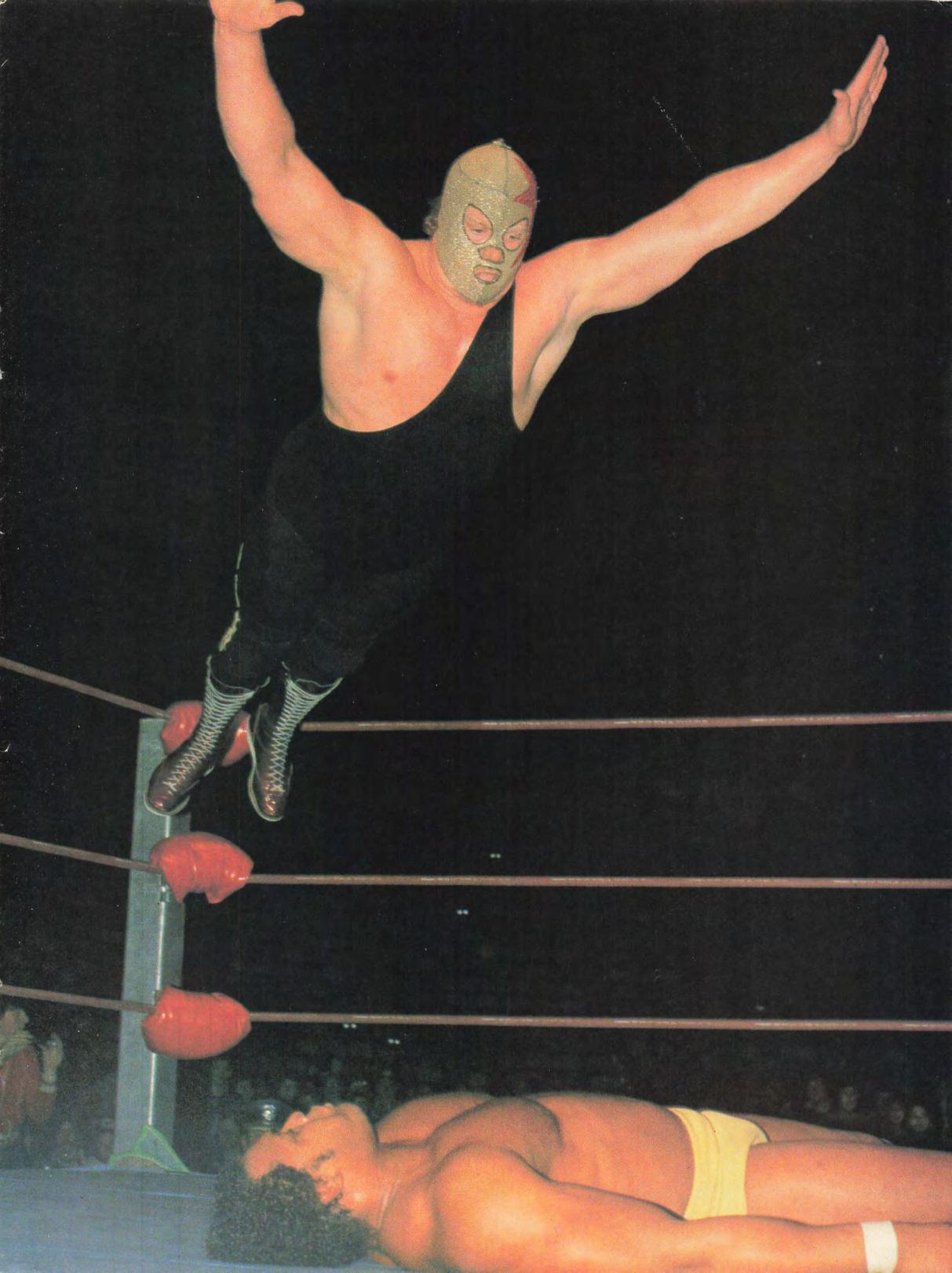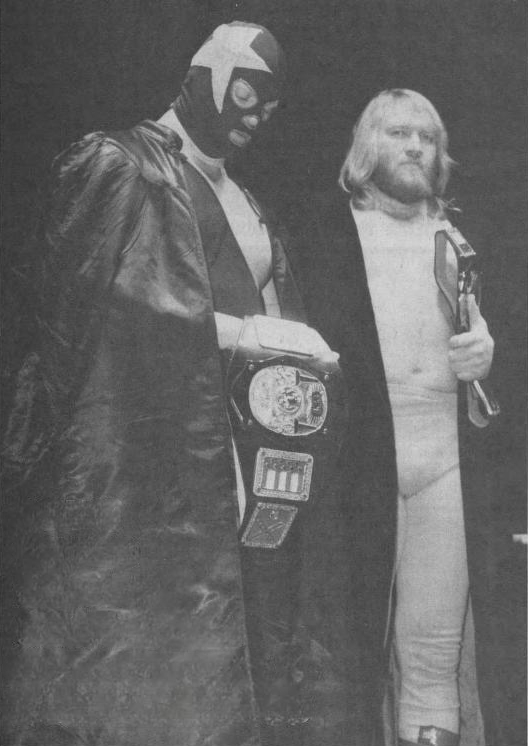1. Overview
Scott Keegan Irwin (May 14, 1952 - September 5, 1987) was an American professional wrestler known for his imposing physical presence and versatility in various gimmicks. Born in either Duluth, Minnesota or St. Petersburg, Florida, Irwin developed a reputation as a natural, large heel. He was widely recognized for his tag team with his real-life brother, Bill Irwin, as part of "The Super Destroyers" and "The Long Riders." Irwin is also credited as a pioneer of the Superplex, a move he popularized. His career spanned from 1976 until his untimely death in 1987 at the age of 35 due to a brain tumor, leaving a notable, albeit brief, impact on the wrestling world.
2. Early Life and Background
Scott Keegan Irwin was born on May 14, 1952. While some sources state his birthplace as Duluth, Minnesota, others indicate St. Petersburg, Florida. He was the older brother of Bill Irwin, who would also become a professional wrestler and his most prominent tag team partner. Scott Irwin possessed a naturally large physique that made him a formidable presence in the ring from the outset of his career.
3. Professional Wrestling Career
Scott Irwin's professional wrestling career was marked by a series of distinct gimmick changes and successful partnerships across various promotions, establishing him as a prominent figure in the American wrestling scene and beyond.
3.1. Debut and Early Years
Irwin began his wrestling training under the tutelage of Verne Gagne in 1975. He made his official professional wrestling debut on March 13, 1976, for the AWA in Davenport, Iowa, where he wrestled to a time limit draw against another rookie, Dick Blood. Initially primarily engaged in preliminary matches within the AWA, he later moved to Georgia Championship Wrestling in June 1976, remaining there until the spring of 1977. Following his stint in Georgia, Irwin joined Mid-Atlantic Championship Wrestling, where he wrestled until early 1978. During his early career, he also competed in other regional territories such as San Francisco in California.
3.2. World Wide Wrestling Federation (WWWF)
On March 14, 1978, Irwin debuted in the World Wide Wrestling Federation (WWWF), adopting the ring name "Lumberjack Eric" and forming half of The Yukon Lumberjacks tag team. His partner, Zarinoff Lebeouf, was rebranded as "Lumberjack Pierre" (originally Pierre Lafleur from Quebec, Canada). Shortly after their debut, The Lumberjacks began a feud with Dino Bravo and Dominic DeNucci. Their first championship encounter on June 2 ended in a double disqualification. However, after several unsuccessful rematches, The Lumberjacks defeated Bravo and DeNucci to capture the WWWF World Tag Team Championship on June 26, 1978. They successfully defended their title for several months against teams including Bravo and DeNucci, Gorilla Monsoon and S.D. Jones, and Haystacks Calhoun and Tony Garea. Their reign concluded on November 21, 1978, when they lost the championship to Garea and Larry Zbyszko. Following this loss, Pierre retired from wrestling, and Eric departed the WWWF.

3.3. Gimmick Changes and Regional Success
After leaving the WWWF, Irwin ventured into Championship Wrestling from Florida (CWF) in December 1978, where he transformed into "Thor the Viking" and was managed by Oliver Humperdink. As Thor, he achieved significant success, including winning the NWA Southern Heavyweight Championship (Florida version) from Terry Funk on January 20, 1979. He also teamed with Jos LeDuc to win the NWA United States Tag Team Championship (Florida version) from Jack Brisco and Jerry Brisco on February 17, 1979. His final match as Thor was a victory over Steve Keirn on October 14, 1979.
The following month, Irwin returned to the CWF as the masked "Super Destroyer." Under this persona, he joined Humperdink's stable, aligning with wrestlers such as Bad Leroy Brown, Bugsy McGraw, and Nikolai Volkoff. This alliance led to intense feuds with prominent babyfaces like Dusty Rhodes, Manny Fernandez, and Mr. Florida.
In November 1980, Irwin, still as the Super Destroyer, debuted in Mid-South Wrestling (MSWA), where he lost to Ted DiBiase. He returned to Mid-South on April 18, 1981, winning the UWF Tag Team Championship with The Grappler in a tournament final for the vacant title against Dick Murdoch and the Junkyard Dog. However, they lost the championship back to Murdoch and JYD just nine days later, on April 27. The Super Destroyer quickly rebounded, winning the Mid-South Louisiana Heavyweight Championship on May 1, a title he held for over two months before losing it to Bob Roop on July 22. Irwin continued to wrestle as the Super Destroyer after joining the Continental Wrestling Association.
3.4. The Super Destroyers (with Masked Superstar)
In 1982, Scott Irwin formed a formidable masked tag team, "The Super Destroyers," with the Masked Superstar (also known as Big John Studd at times). This duo soon moved to Georgia Championship Wrestling, continuing their success by winning the NWA National Tag Team Championship on January 22, 1982, from the Armstrongs (Bob and Brad Armstrong). In March, Masked Superstar transferred his half of the title to Big John Studd, and the new pairing of Super Destroyer and Studd lost the title to The Fabulous Freebirds on July 2. During this period, Super Destroyer also engaged in super-heavyweight contests across the Southern territories, including a notable feud with Andre the Giant.


3.5. The Super Destroyers (with Bill Irwin)
Following his partnership with Masked Superstar, Scott Irwin formed a new iteration of "The Super Destroyers" tag team with his real-life brother, Bill Irwin. Bill adopted the persona of Super Destroyer No. 1, while Scott became Super Destroyer No. 2. Managed by Skandor Akbar, the brothers debuted in World Class Championship Wrestling (WCCW) in Dallas, Texas in late 1983. They quickly captured their first NWA American Tag Team Championship in October 1983 by defeating Bulldog Brower and Roddy Piper.
The Super Destroyers engaged in a significant feud with Iceman King Parsons and Buck Zumhofe, collectively known as "Rock 'n' Soul." They lost the American Tag Team title to Rock 'n' Soul on December 25, 1983, but regained it on January 30, 1984. After holding the title for four months, they lost it again to Rock 'n' Soul. However, just thirteen days later, The Super Destroyers recaptured the championship. Immediately after this match, Rock 'n' Soul famously unmasked the brothers, revealing their true identities.
3.6. The Long Riders
After being unmasked as The Super Destroyers, Scott and Bill Irwin dropped their masked personas and began wrestling under their real names as a tag team known as "The Long Riders." This new gimmick portrayed them as bikers who rode Harley-Davidson motorcycles. They continued their feud with Rock 'n' Soul, losing the American Tag Team title again on August 4, 1984, after Parsons defeated Bill in a singles match. The Long Riders secured their fourth and final reign as NWA American Tag Team Champions on September 28, once more defeating Rock 'n' Soul. Their last reign concluded on October 22, when they lost the titles to The Fantastics (Tommy Rogers and Bobby Fulton).
On November 18, 1984, The Long Riders returned to Georgia Championship Wrestling, where they won the NWA National Tag Team Championship in a one-night tournament, defeating Brad Armstrong and Jacques Rougeau. They successfully defended the newly won title the following night against Armstrong and Tommy Rich. However, on January 11, 1985, The Long Riders lost the NWA National Tag Team Championship to Ole Anderson and Thunderbolt Patterson. After losing a rematch the following night, Scott Irwin had to find new partners, Kareem Muhammad and then Doug Somers, for two subsequent rematches against Anderson and Patterson due to Bill's departure from GCW, but was unable to regain the title. Scott wrestled a few more matches in GCW before also leaving the promotion.
In mid-1985, The Long Riders resurfaced in the AWA. They lost their debut match on July 14, 1985, against the Road Warriors for the AWA World Tag Team Championship. On September 28, at SuperClash, The Long Riders and Harley Race lost a six-man tag team match to Genichiro Tenryu, Giant Baba, and Jumbo Tsuruta. The Long Riders continued in the AWA until April 20, 1986, when they lost a tag team title match to Curt Hennig and Scott Hall at WrestleRock. The Long Riders also worked for Gino Brito's Lutte Internationale promotion in Montreal, Canada, where they won the Canadian International Tag Team Championship on March 6, 1986, from Dan Kroffat and Solofa Fatu. During his time in Montreal, Scott Irwin continued to wrestle even while undergoing treatment for cancer, which caused him to lose his hair.
3.7. Career in Japan
Scott Irwin made a total of three tours to All Japan Pro Wrestling (AJPW), always appearing under a mask. His initial visit occurred in October 1980 for the 'Giant Series,' where he was introduced as "The Asteroid" (ジ・アステロイドThe AsteroidJapanese). During this tour, he formed a large masked tag team with the veteran The Avenger. However, despite the presence of a star-studded roster that included Terry Funk, Abdullah the Butcher, Wahoo McDaniel, Bill Robinson, Dick Murdoch, and Killer Tor Kamata, The Asteroid did not achieve significant prominence.
His second tour came in November 1982, when he participated in the '82 World's Strongest Tag Team League' as "Super Destroyer" (スーパー・デストロイヤーSuper DestroyerJapanese), teaming with Ueda Masanobu. Despite their status as an impromptu team, which resulted in them finishing at the bottom of the league with zero points, legendary referee Lou Thesz notably assessed Irwin's physical strength to be superior to that of even Stan Hansen or Bruiser Brody. During this period, there were also rumors that Scott Irwin, as Super Destroyer, might participate in New Japan Pro-Wrestling's 3rd MSG Tag League, teaming with the Masked Superstar, with whom he had previously partnered in Georgia.
Scott Irwin's final tour of Japan was in February 1984 for the 'Excite Series.' For this tour, he reunited with his brother, Bill Irwin, as "The Super Destroyers" (スーパー・デストロイヤーズThe Super DestroyersJapanese). On February 26, they challenged Ashura Hara and Takashi Ishikawa for the AJPW All Asia Tag Team Championship at the Osaka Prefectural Gymnasium. Although he never appeared in Japan unmasked, Scott Irwin had previously wrestled unmasked alongside Bruiser Brody on June 29, 1980, in Toronto, Canada, where they challenged Giant Baba and Jumbo Tsuruta for the NWA International Tag Team Championship.
4. Signature Moves
Scott Irwin was known for several powerful wrestling maneuvers, with one in particular standing out:
- Superplex (スーパープレックスSūpāpurekkusuJapanese): A brainbuster performed from the top rope, for which Irwin is widely credited as a pioneer or innovator. The name "Superplex" is said to have been derived from a shortened version of his "Super Destroyer" ring name, "Super-D."
- Canadian backbreaker: Primarily used during his time as "Lumberjack Eric" in The Yukon Lumberjacks.
- Avalanche Hold
- Elbow drop
5. Championships and Accomplishments
Scott Irwin achieved numerous championships and accolades throughout his professional wrestling career:
| Accomplishment | Times | Notes | |
|---|---|---|---|
| Cauliflower Alley Club | Posthumous Award (2007) | Shared with Betty Joe Hawkins | |
| Championship Wrestling from Florida | NWA Florida Tag Team Championship | 1 time - with Bugsy McGraw | |
| NWA Southern Heavyweight Championship (Florida version) | 1 time | ||
| NWA United States Tag Team Championship (Florida version) | 1 time - with Jos LeDuc | ||
| Georgia Championship Wrestling | NWA National Heavyweight Championship | 1 time | |
| NWA National Tag Team Championship | 3 times - with Big John Studd (1), Masked Superstar (1), and Bill Irwin (1) | ||
| Lutte Internationale | Canadian International Tag Team Championship | 1 time - with Bill Irwin | |
| Pro Wrestling Illustrated | PWI ranked him No. 77 of the 100 best tag teams of the "PWI years" (2003) | With the Masked Superstar | |
| Mid-South Wrestling Association | Mid-South Louisiana Heavyweight Championship | 1 time | |
| Mid-South Tag Team Championship | 1 time - with The Grappler | ||
| World Class Championship Wrestling | NWA American Tag Team Championship | 4 times - with Super Destroyer #1/Bill Irwin | |
| WCCW Television Championship | 2 times | ||
| World Wide Wrestling Federation | WWWF World Tag Team Championship | 1 time - with Yukon Pierre | |
| Wrestling Observer Newsletter | Best Wrestling Maneuver (1982) | For the Superplex |
6. Death
On September 5, 1987, Scott Irwin died at the age of 35 due to a brain tumor. His passing was a significant loss for the wrestling community, particularly given his relatively young age and the promise of his career. Anecdotes from the time describe Irwin, upon receiving his terminal diagnosis, making farewell visits to the homes of his former colleagues and rivals to express his gratitude and say goodbye before his death.
7. Legacy
Scott Irwin's legacy in professional wrestling is primarily marked by his influential contribution to wrestling techniques, particularly the Superplex. He is widely recognized as a pioneer or innovator of the move, which became a standard in the sport. His ability to adapt to various gimmicks, from a lumberjack to a masked destroyer and a biker, showcased his versatility and athleticism. Despite his relatively short career, cut short by illness, Irwin achieved significant championship success, particularly as a tag team specialist with his brother Bill Irwin and with Masked Superstar. His posthumous recognition, including an award from the Cauliflower Alley Club and being ranked by Pro Wrestling Illustrated for his tag team with Masked Superstar, underscores his lasting impact and place in wrestling history.